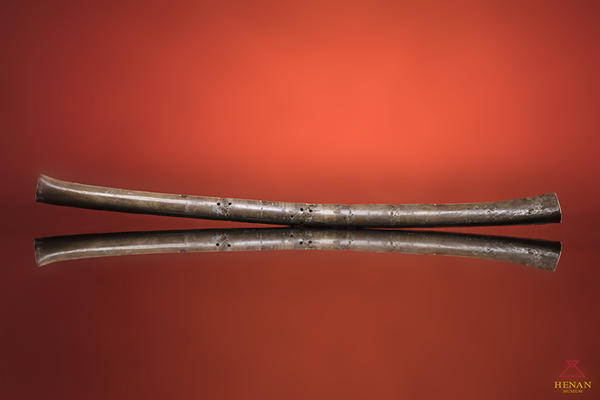Treasures of Central Plains · The Fine Details Behind丨The Jiahu Bone Flute
Editor's notes: For those who are staying at home during the global
COVID-19 pandemic, an excellent cultural feast is needed to cheer them up! Ma
Xiaolin, director of Henan Museum, has spent many years studying abroad or serving
as a visiting scholar. As an attempt to promote Henan’s cultural relics “going
global” and realize the internationalization of Henan Museum, he has recorded a
series of videos named “Treasures of China’s Central Plains” in English for the
first time to tell the stories behind the cultural relics, present international
friends with exquisite artifacts and demonstrate the profound Chinese civilization
to the outside world.
时下,全球疫情仍在持续,人们被困家中更需一股文化的力量来凝心聚气。有着多年国外留学和担任访问学者经历的河南博物院院长马萧林,首次以纯英文的方式录制《中原藏珍》系列视频讲述中国河南文物故事,向外国朋友展示古老器物的精美,传递源自久远的中华文明,同时也是让中原文物走向世界、实现河南博物院国际化的一项有益尝试。
Episode I
第一集
The Jiahu Bone Flute
贾湖骨笛
I. The flute
一、骨笛
The bone flute was unearthed from the Jiahu Site, Wuyang County, Henan Province, in 1987, thus its name the Jiahu bone flute. This 23.6cm-long flute was made from a wing bone of the red-crowned crane 8,000 years ago, with seven finger holes. The finger holes on this wind instrument were precisely drilled by first locating the hole for the tonic note “gong” in the Chinese pentatonic scale. The tonic note “gong” is equivalent to “Do” in modern music. The other finger holes were then fixed according to the place of the "gong" hole. However, a thinner flute sounded different from a thicker one. Thus, smaller holes were drilled next to the seven larger finger holes, for sound checking. The technique was quite similar to a modern one used on traditional Chinese wind instruments.
贾湖骨笛,1987年出土于河南舞阳贾湖遗址,因而得名。笛身长23.6厘米,开有七孔,以鹤类禽鸟尺骨钻孔制作而成,距今约8000年。笛上音孔,以五声音阶中的“宫”音为基准,磨制精细。“宫”音相当于现代音乐中的“Do”音。其它音孔的位置根据“宫”音相继确定。然而,由于骨管粗细不一,极易产生音差,故在七孔旁开小孔加以校正。骨笛的制作方法和过程,与现代中国民族管乐器的制作方法非常相似。

II. Excavation
二、发掘
Located in Wuyang County in central Henan and an important site from the Peiligang culture, the Jiahu Site expands over an area of over 50,000 square meters and dates back to 9,000–7,500 years ago. Eight excavation projects were launched in the site between 1983 and 2013. More than 3,000 square meters were under excavation and thousands of cultural relics unearthed, including more than 40 bone flutes.
贾湖遗址,位于河南省舞阳县,是裴李岗文化的重要遗存,占地面积5万多平方米,距今9000 - 7500年。1983年至2013年间,考古人员对贾湖遗址进行了8次发掘, 发掘面积3000多平方米,出土文物数以千计,其中包括40多支骨笛。
The bone flute was in three pieces at the excavation. There were a number of joining holes, indicating that it had been carefully repaired and evidently a favorite to the owner. Yet, once restored, the three pieces made an intact bone flute that was dark brown in color and smooth in surface. The other bone flute unearthed together was well preserved.
除了保存完整的骨笛外,有的骨笛在出土时就已经断为三截,但每一断裂处均有多个缀合孔,说明它折损后曾被精心修复,足见主人十分珍爱。修复后的骨笛整体呈褐色,通体光滑晶莹。
III. How was it made
三、制作
The bone flute was made from a wing bone of the red-crowned crane. The Jiahu Site was rich in fauna. Skeletons found there included those of swans, ring-necked pheasants, and red-crowned cranes. The bones of a red-crowned crane are hard and hollow. A primitive artisan may first cut off the bone heads on both ends. Then he would determine the placement of the finger holes before drilling them on the bone. Finally, tone tuning was made to this musical instrument. Cuts were found besides the finger holes, showing that repeated corrections had been made in the process. It was difficult to drill the finger holes and smaller tone-tuning holes on a hard yet fragile bone of a crane. Filing was not an easy job, either.
贾湖遗址所在的地区,动植物资源丰富,在那里发现了大量野生动物的骨骼,包括天鹅、环颈野鸡和丹顶鹤,骨笛的管身就是由丹顶鹤的翅膀骨制作而成。丹顶鹤的骨骼外坚内空,当时的工匠们在制作骨笛时会锯掉两端骨节,确定音孔的位置,钻孔,最后调音。钻孔旁边还发现了一些钻头轻点后留下的痕迹,充分说明,在骨笛的制作过程中,需要不断地进行校正。鹤骨坚硬却脆弱,要在上面钻出或者磨出圆润规整、孔径一致的音孔(以及更小的调音孔)并不是一件简单的事情,如何保存也是一个问题。
The microscopic examination showed spiral marks left by a running bit inside the finger holes. Hand drills and brad awls made of hard-textured materials such as crystal and flint were unearthed from the site. However, it was hard to reproduce the bone flute with similar tools and means. The Jiahu bone flute must have been a result of time-consuming experiments to find the best material and technique.
考古专家在贾湖遗址里发现了一些水晶和隧石类坚硬材料制作而成的手钻或锥钻。在显微镜下,也可以看到钻头在音孔内留下的螺旋形钻痕。在骨笛的制作过程中,先民们会进行数次尝试,以便找到最好的材料和最适合的技术。然而,今天用类似的工具和手段也很难再制作出骨笛了。
IV. Significance
四、意义
More than forty bone flutes were unearthed from the Jiahu Site. They evidently followed the line of development from being simple in shape and design to getting more complicated and refined. These bone flutes fitted well the archaeological phases they belonged to. The earliest Jiahu bone flutes were supposed to be made 9,000 years ago, progressively with two, five, or six finger holes. With a millennium development or so, the bone flutes were developed into a seven-hole instrument. Later, eight-hole bone flutes emerged. The musical scale grew from a four-tone one to a five-, six-, and seven-tone. There were even sound changes.
贾湖骨笛经历了不同的发展阶段,早期形状设计单一,后来逐渐复杂精良,这与贾湖文化的分期基本一致。贾湖遗址共发掘出土了四十多支骨笛,据推测,最早的贾湖骨笛制作于9000年前,开有两孔、五孔或六孔。经过上千年的发展,骨笛已经成为一种七孔乐器。后来,还出现了八孔骨笛,音阶也从四音发展到五音、六音和七音,而且还出现了变化音。
Chinese music has a long history. It emerged in the production activities of primitive men. Primitive men of eight thousand years ago already played a "xiazhi" tune on the bone flute. It has been a piece of solid evidence to Chinese music in remote antiquity.
中国音乐有着悠久的历史,这与先民们的生产生活息息相关。八千年前的先民们就已经能够使用骨笛吹奏出动人的下徵音阶了。贾湖骨笛的发现,充分说明了远古时期中国音乐的发展。
The Jiahu bone flute served as an important object that facilitated our understanding and study of the development of the Chinese music civilization and its early form. The discovery of the Jiahu bone flute dates China’s music history back more than 8,000 years.
同时,贾湖骨笛作为重要文物,有助于我们理解和研究中国音乐文化及其早期形式,并将中国音乐史的起源提前到了8000多年前。
The Jiahu bone flute is believed to be the earliest wind instrument ever found in the world which remains playable even this day, and it provides an important clue to the study of the world’s music history. Also, the bone flute was a piece of solid evidence to the music art and creativity of primitive men. Ancient residents of the Jiahu Site successfully developed a two-hole bone flute to a seven-hole one. They may create the first bone flute unintentionally; yet, they later made one breakthrough after another with all their efforts.
贾湖骨笛是世界上发现年代最早、至今尚可演奏的乐器,为世界音乐史的研究提供了重要线索,充分证明了先民们的音乐艺术和创造力。生活在贾湖附近的先民们,成功地把两孔骨笛发展成了七孔。虽然他们可能是无意中制作出的第一支骨笛,但经过不懈努力,却取得了一个又一个的突破。(来源/河南博物院 翻译/赵汉青 审校/李文竞)

